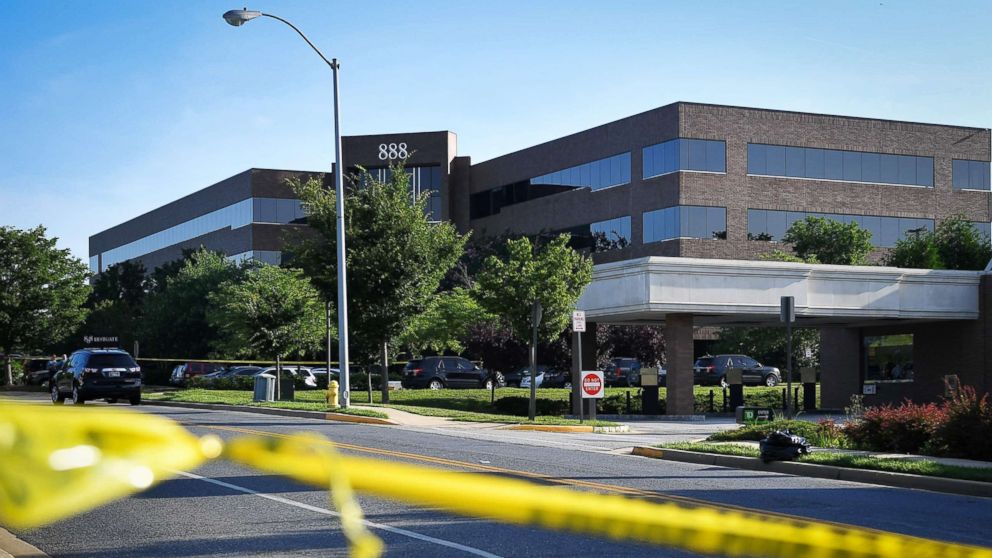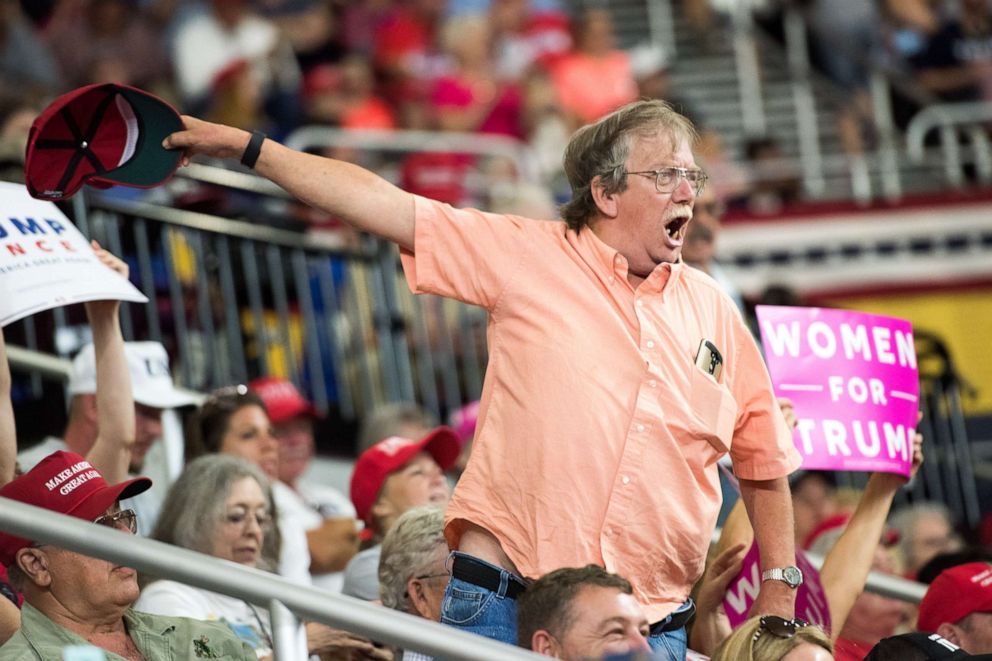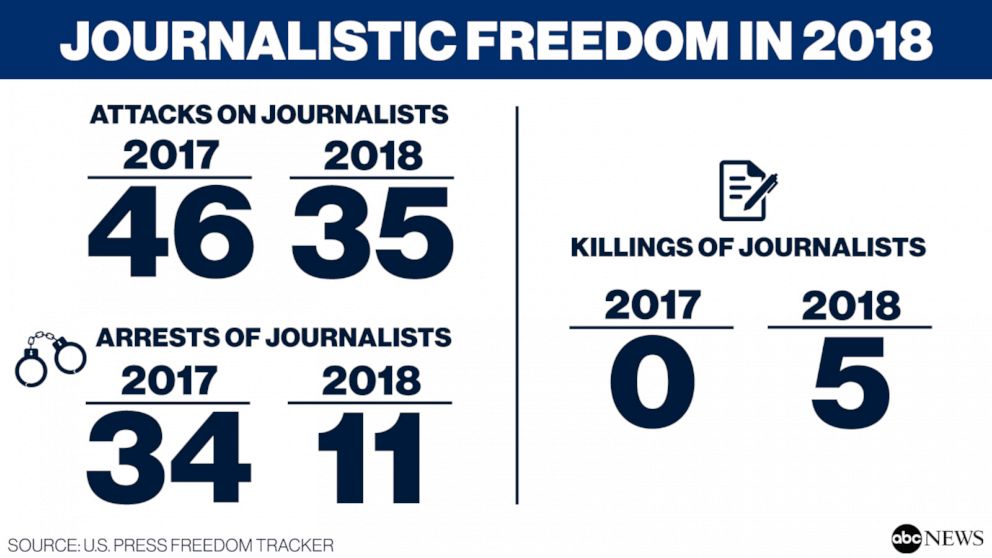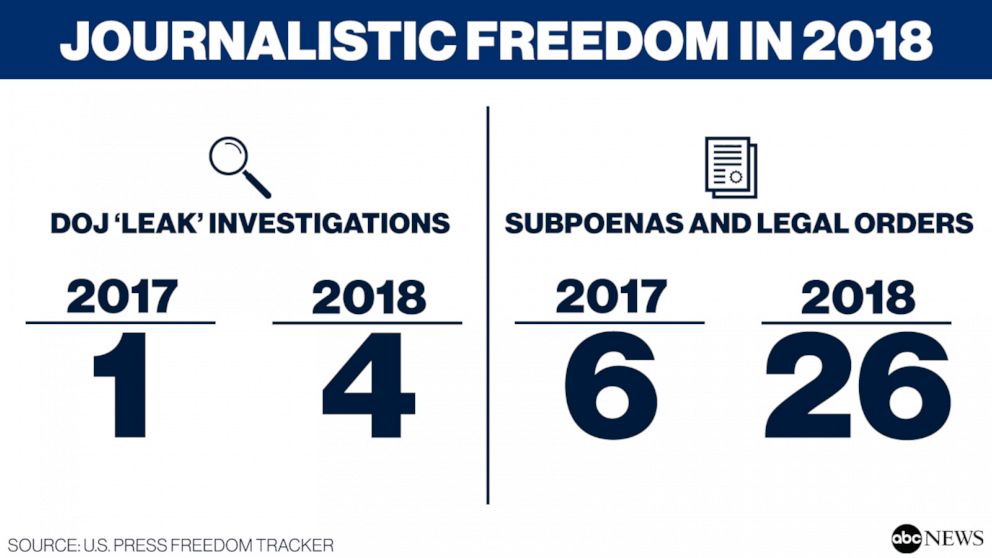From verbal taunts to shots fired: How journalists were attacked in the US in 2018
A new report evaluates the state of press freedom in the US in 2018.

A reporter got punched in the face by a stranger in New York, and another was punched while reporting on the aftermath of Hurricane Florence in North Carolina.
Three reporters were covering a car crash when a man with a metal baton started attacking their vehicles.
Those were among the lower-profile attacks on journalists in 2018. Others received more widespread attention, like when a series of mail bombs was sent to a major news network's headquarters, among other targets.
And when an alleged gunman opened fire in a newsroom, killing four journalists and a sales assistant.
These were just some of the attacks on journalists in the U.S. in 2018, all featured in a new report released Friday, on World Press Freedom Day.
The report looked at data collected by the U.S. Press Freedom Tracker, which is made up of more than two dozen press freedom groups and is managed by the Freedom of the Press Foundation. It studied the attacks on press freedom, both in terms of physical impositions on the reporters and also on their ability to do their job.
The number of attacks on, and arrests of, journalists decreased in 2018 compared to the previous year, while Department of Justice ‘leak’ investigations went up, according to the report. The number of subpoenas and legal orders issued against reporters increased, too, the report found.
While those numbers fluctuate given the news in various years and the relationship that the respective administrations have with the media, there was something different about this year’s evaluation: researchers had to add a category for the killings of journalists.
The shooting at the offices of The Capital Gazette in Annapolis, Maryland, which left five dead, marked the first time in years that a journalist has been killed in the United States because of their reporting.

The last such murder of journalists in the U.S. was in 2015 when Alison Parker and Adam Ward of Virginia station WDBJ were killed by a former colleague during a live shot.
Before that, reporter Chauncey Bailey was killed in 2007 in retribution for a story he was investigating.
The report does not include the murder of The Washington Post columnist Jamal Khashoggi because it occurred abroad.
Sarah Matthews, the author of the report and a staff attorney at the Reporters Committee for Freedom of the Press, said that The Capital Gazette shooting on June 28 “has really shaken up journalists across the country.”
“Fortunately, killings of journalists have been pretty rare in the U.S.," Matthew said, noting that the shooting happened in a wider "context of also seeing a lot of vitriolic rhetoric targeted at journalists.”
What words have to do with it
The report notes that the media “has experienced increasing hostility” that has been “stoked by virulent attacks from politicians,” and adds that the Committee to Protect Journalists tracks the tweets that President Donald Trump posts about the media. It does not, however, draw a direct line between Trump’s criticism of the media and the attacks on journalists that happened during his tenure.
“We just don’t know causation,” Matthews told ABC News.
“We know that this rhetoric has created an environment where journalists are feeling targeted, and ... it’s created this tense, hostile, anti-media environment," she said, adding that it's impossible to know the extent that the rhetoric impacted the attacks.
Trump and his administration have repeatedly denied that his verbal attacks against the “fake news” and those he calls “the enemy of the people” have led to the actions of others.

After the shooting at The Capital Gazette, Trump said he condemned the shooting and spoke out on behalf of reporters.
“Journalists, like all Americans, should be free from the fear of being violently attacked while doing their job,” he said at the time.
For their part, the surviving staffers at The Capital Gazette penned an editorial after the shooting, mourning their colleagues and adding that they “won’t forget being called an enemy of the people.”
Beyond the seemingly unprompted acts of violence, protests continue to be events ripe for physical attacks on journalists, but the report notes that since there were fewer high-profile, confrontational protests last year compared to 2017, a smaller percentage of assaults on journalists took place at protests.
In 2017, when Trump was inaugurated and reporters were arrested while covering the Dakota Access Pipeline protests at Standing Rock, among other events, protests were where 31 of the 46 assaults on journalists, according to the report; the following year, only 13 of the 35 assaults on journalists occurred at protests, the report found.
That said, in 2018 protests were still the most common situation where a journalist was arrested while doing their job.

Five of the 11 arrests happening at protests in 2018, according to the report. It notes that in all five of those cases, charges were either never formally filed or were dropped.
The overall arrest number is still markedly lower than the 34 arrests of journalists that occurred in 2017.
Other encroachments on journalistic freedom
There are also ways to send a chilling message to journalists and the free press without using physical violence, the report notes, including launching investigations into leaks and issuing subpoenas for information held by journalists.
“One of the most troubling trends in 2018,” the report states, “was the acceleration of federal prosecutions against government employees for sharing government material and information with the news media.”

The report notes that the Obama administration had set a new “high water mark” by prosecuting 10 leaks in eight years, but the Trump administration has continued that upward trajectory by prosecuting six people in two years, four of them in 2018 alone.
While largely focusing on 2018, the report singled out one case that occurred this year under the new Attorney General William Barr, warning that he continues to bring leak prosecutions.
“Barr would be building on his predecessor’s record,” the report notes.
Another “disturbing trend” identified in the report is the uptick in subpoenas and legal orders -- which are typically used to force a reporter to reveal the source of some information that they publicized or in relation to records that were obtained -- that were reported to the U.S. Press Freedom Tracker. That figure increased from six reported in 2017 to 26 in 2018.
Those numbers are based on cases that receive publicity or are reported to the tracker, and therefore could be missing a number of subpoenas or legal orders that are kept private.
The individual cases, whether they be a reporter being asked by a governing body to turn over the names of a source or a series of mail bombs sent to CNN, Matthews said that looking at the collective list of attacks on press freedom helps “put everything into context.”
“Putting this all together,” Matthews said, "it was really heavy."




